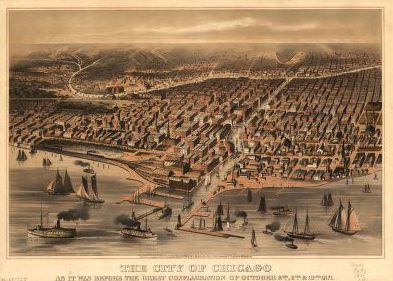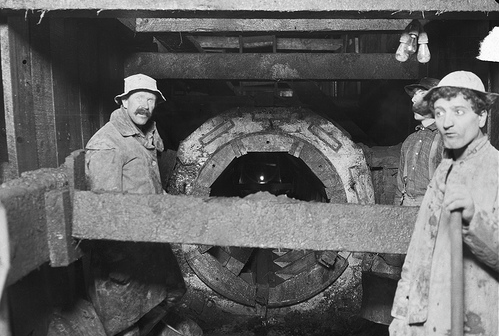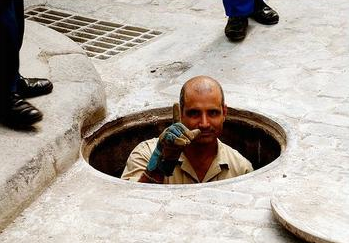After the fall of the Roman Empire, Europeans despised all things Roman, including bathing.
There was a widespread fear that getting wet caused illness. This fear persisted for hundreds of years and was brought across the Atlantic to America.
People used to use a pitcher, bowl, and washcloths to clean themselves as best they could.
Human waste was deposited into chamber pots, then thrown into the street or anywhere convenient.
The total lack of sanitation provided the perfect environment to spread disease in urban areas.
Polio and cholera thrive in human excrement.
In places with good plumbing and hygiene, these diseases are rare. In places without plumbing they can spread rapidly.
In the mid 1800s, London had very little plumbing. Most people used community pumps and wells to get water, and waste was often dumped into the Thames River.
Unfortunately, the Thames River was also the main source of drinking water.
Cholera spreads easily through contaminated water and kills very quickly; often within hours of the first symptoms.
In 1854, tens of thousands died in a cholera outbreak. At the time, people blamed the disease on ‘vapors’ or ‘God’s vengeance.’
But Dr. John Snow had a different idea. He argued that it was in the water, and traced the outbreak to a pump handle on Broad Street.
After convincing town officials to remove the pump handle, the cholera outbreak abruptly ended.
Some time later, the outbreak was traced back to a woman cleaning a dirty diaper in the well.
Though it took some time, Dr. Snow convinced the authorities that fecal matter was contaminating the water supply.
Today Dr. John Snow is regarded as the father of epidemiology.
Meanwhile in America, Chicago grew from a village of 350 to a small city of 60,000 between 1835 and 1850.
It also had a growing number of typhoid fever outbreaks.
The increase in disease was traced to the city’s water and sanitation. The majority of the city’s sewage was directed to the Chicago River, which flowed right back into Lake Michigan, which provided the city’s drinking water.
This, of course, contaminated Chicago’s drinking water and created a cycle of disease.
In the early 1900s Chicago modernized their water infrastructure, and as a result, cases of typhoid fever and all other infectious diseases plummeted.
Sanitation not immunization.
More recently, immunization efforts have gotten a lot of publicity and credit for India being declared “polio free” by the World Health Organization.
As recently as 2009, India reported 762 cases of polio, and at that time, these numbers made India the polio capital of the world.
In 2014, there are currently no “official” documented cases of polio, but without proper sanitation there is no way this can last.
Currently, 780 million Indians do not have a toilet. Open defecation is still common.
There have been some efforts to improve sanitation, but they pale in comparison to the extensive efforts to vaccinate Indians.
Over 9 billion has been spent in this vaccination campaign. In some parts of India, children have received as many as 30 doses of the oral polio vaccine before their fifth birthday.
Bill Gates, the World Health Organization, and GAVI have ardently been pushing vaccines on people who still don’t have access to clean drinking water or sanitation.
And the vaccine campaign in India has a high rate of injury and death. There were 53,000 cases of NPAFP, among those vaccinated. A disease that is indistinguishable from polio and twice as deadly.
Incidences of the disease rose and fell with the number of doses of the vaccine administered.
To call this disease anything other than polio is just a word game to protect the immunizer’s reputation. India may be “polio free” now, but if 53,000 got NPAFP from the polio vaccine, is that really an improvement?
Remember, in 2009, India reported just 762 cases of polio.
It would be less expensive in human cost and far more effective to improve India’s water and sanitation infrastructure.
Vaccines don’t actually fix the problem, they just ensure a steady stream of future customers.
Sanitation prevents disease by removing the cause of disease transmission, but this is not new information.
Moses taught sanitation.
The Greeks and the Romans created elaborate systems of aqueducts, baths, and drainage.
When the Roman Empire crumbled, sanitation became a lost art. Civilization paid the price as plague after plague struck areas of dense population.
Smallpox continued to infect Europe’s population until plumbing infrastructure became commonplace.
Although, sanitation ended this disease, the smallpox vaccine takes the credit.
If you are reading this, you probably have access to running water and a working toilet. And you probably take these simple utilities for granted, but they are true lifesavers.
Have you thanked a plumber lately?







This article has very good information and the importance of plumbers in solving the health issues has been highlighted very well.
This is so true! All the information you showed are correct. I cannot imagine how the world could be messy without the plumbers who worked on the sewage systems. We owe them a lot.
Just came across this article. I would have to say this is correct. Without the modern day age of plumbing, a lot of diseases would have been unchecked. However, there is still a lot of public health issues in third world countries and with the help of public awareness these problems can eventually be resolved.